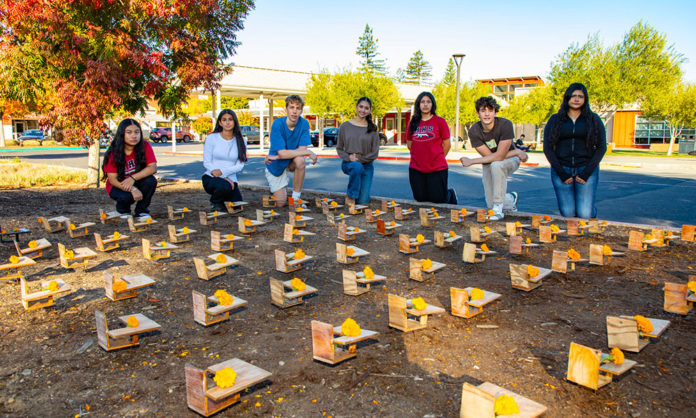
By Christian Kallen
Three years ago, when it seemed that school shootings “were happening every other day,” Linus Lancaster brought a notion to his art class. What can we do to recognize, to feel the loss of fellow students in school shootings?
Inspired in large part by the Raven Players’ production of If I Don’t Make It, I Love You, based on a book composed of messages from children, students and their family members in the grip of mass shootings, the class decided to go from there.
That book and play covered narratives of shootings from 1966 at the University of Texas’ Austin Tower, through May 2018’s Santa Fe High School shooting. Heartbreaking communications from those at emotional extremes struck a chord with the audience, Lancaster and his students included.
Lancaster and six students in his 2023 art class, which graduated over a year ago, decided to build small replica school desks to represent each student killed since the If I Don’t Make It timeline, after Santa Fe.
Now, 20 months later, the project is done. “I wasn’t sure when we would ever finish, but it looks like we now have 108 desks, one for every student killed in a school shooting since 2018,” Lancaster said on the last day of October.
“Having planted them around town during the past two years, we are now planning to put all of them together in front of the school just for a day,” he added. That reveal took place last week, Thursday afternoon at Healdsburg High School.
A Cemetery of Desks
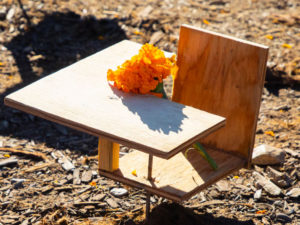
The desks are small, even tiny, measuring six by six by five inches, made of 1/8th-inch varnished plywood. There’s a seat with a back and a wrap-around writing desk, old school. Small finishing nails secure the structures. In the seat of each one sits a single marigold.
They are arrayed on the narrow strip of grass in regular rows and lines, 108 of them, the marigolds glowing in the afternoon sun. The desks face the high school where students move from class to class. Taken together, the nine dozen fragile desks take on an accumulated force.
After an intervening year, another six members of his second art class took an interest, and gathered a task force to finish the project. Now they stand arrayed around the grassy graveyard—it suddenly becomes clear the desks have another dimension of meaning—exchanging ideas on what the project meant to them.
Andrea Zamudio, a soft-spoken girl, is nonetheless the first to speak. “I think the whole project is very meaningful and worth the time on making this,” she says. “I just hope that this makes a difference.”
She forces herself to continue. “I think it’s important to think about this and plan ahead for this. Students and teachers, I know they practice how to hide and stuff.” She laughs nervously.
“My mom has always kind of been an advocate for gun violence, and so I guess she kind of passed that on to me,” says a more confident Amelia Low, meaning gun violence awareness. “Just bringing awareness to the fact that it’s way too common in America is kind of important to me.”
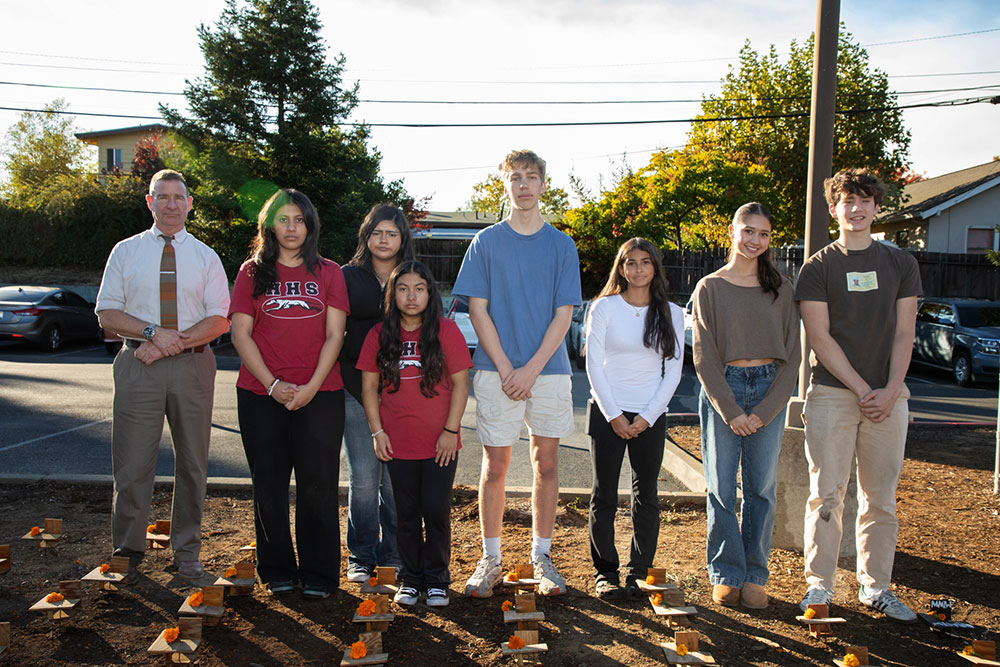
She doesn’t smile when she says, “You can see, with this art project, the amount of people who have died. I mean, 108 people is about the amount of people in my class of 2026.”
The art class of 2026 working on this project consists of one boy, Justus Scarioni, and five girls—Andrea, Amelia, plus Wendy Garcia, Yaretzy Lopez and Venessa Vazquez.
Standing out from the rest, not only because he’s a head taller than any of the other students, is a seventh, Tristan Jensen, class of 2027.
“When I was doing this project, I really dug deep within myself and found a passion for resisting guns and gun violence,” Jensen says. “All these kids have fallen from the tragedy of guns … And I just find it like, like, almost like my call to arms, to help out where I can for defending kids in schools.”
His friend Justus Scarioni, back in the class of 2026, steps up. The project manager of the crew, more or less, he is casually quick about sharing the credit.
“Mr. Lancaster told the whole class about it and I was one of the first, actually me and her, Amelia, were the first to step up to the plate,” Scarioni says. Others joined in, and inside of two months it was done. “We had a good project and it turned out really well,” Scarioni says, speaking for all of them.
Lancaster steps up. “I was hoping that we would be able to get this installation out during a time of comparative quiet, because we don’t only want to engage with this when something happens,” he says. It’s a point several of the students make as well, that it’s quiet right now, two days after the election, but it won’t always be.
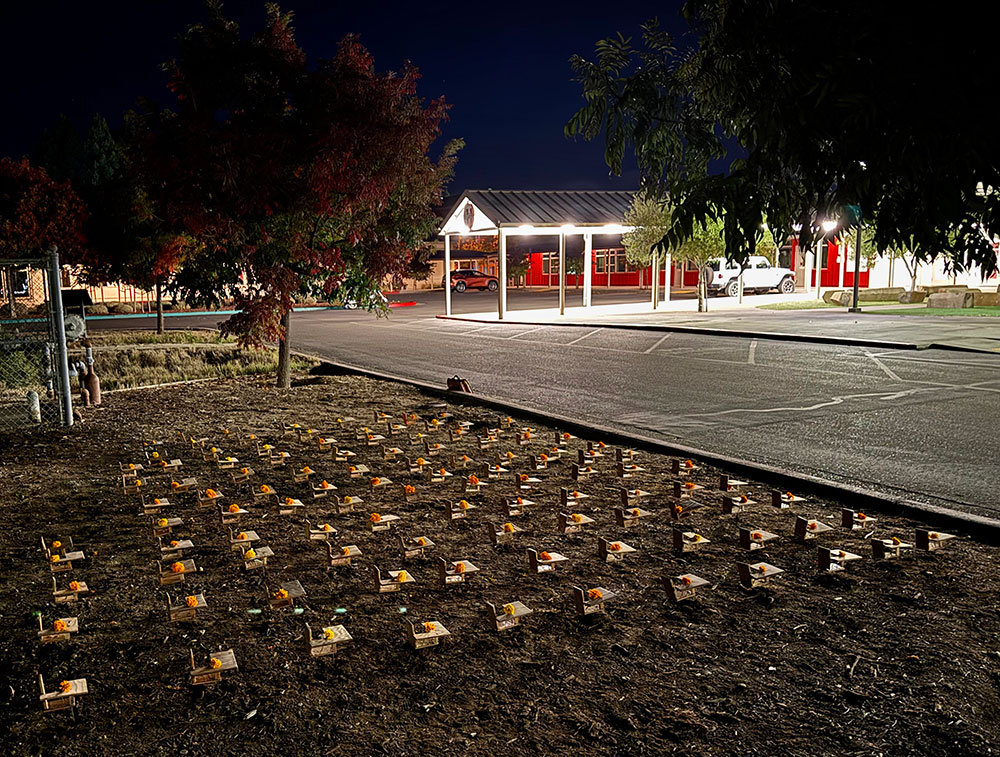
And as the teacher says, “When it’s in the news everyone is yelling at each other, and it’s the same people having the same arguments every time. And then it dies away from the media in four or five days, and then nothing has changed.”
Andrea gets my attention. “I think that it could not just be these people from outside being evil and coming into schools to shoot. I think we can’t trust anybody,” she says. “I think students could do that, too. Anybody could bring a gun, right? A student or a teacher.”
She continues, “There has been this shooting, I forget where, a student shooting his own class, his own school. Whether it was for bullying reasons or anything, schools should be aware of how students treat other students, to prevent students shooting other students.”
Lancaster fills the awkward, hurt silence, saying, “We know from what’s happened in past years that there isn’t a common profile of a school shooter. It can be anyone. And so, as Andrea said, how we treat each other becomes very, very important.”
The next day the installation—108 desks—is due to be dismantled and returned to storage, until the next time it’s needed. Where will they be stored?
“I have no idea,” Lancaster says. “How about your place?”
Linus Lancaster and his art class will be making teacher desks to represent the staff and faculty who have been killed as well. They hope to re-install the complete set in a public site in the coming months.

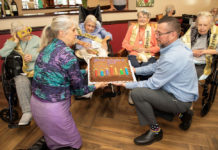

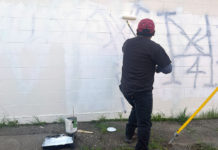




Why is there more security at airports than at government schools?